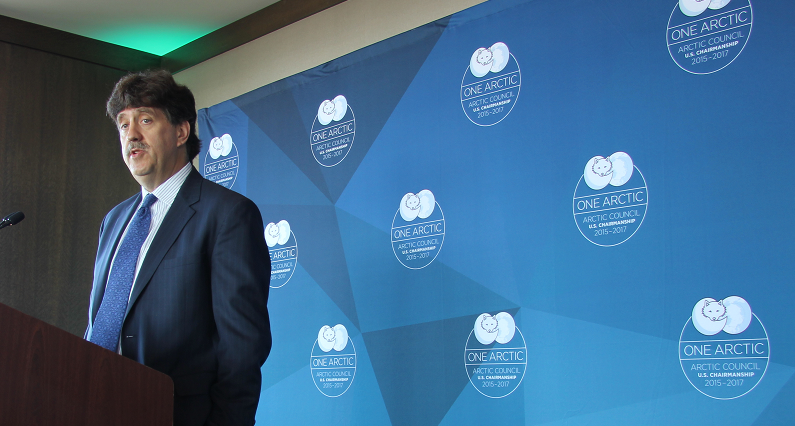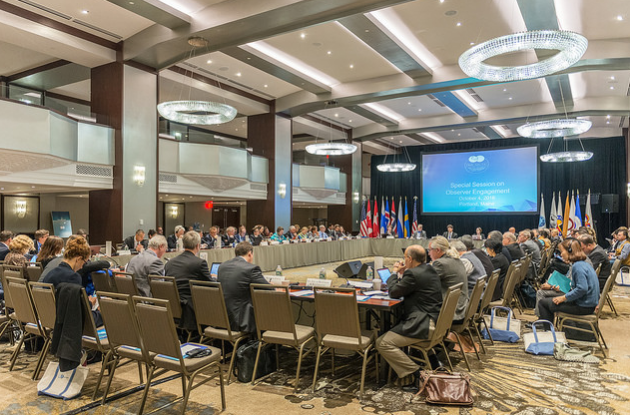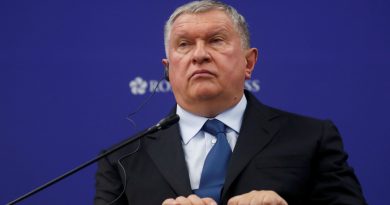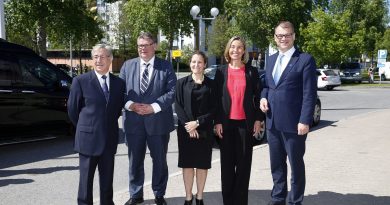Climate, politics and the question that just won’t die: Arctic Council meeting winds up in Maine

Portland, Maine – Climate change was at the top of the agenda during this week’s Arctic Council Senior Arctic Officials Meeting, said U.S. Ambassador David Balton, Chair of the Senior Arctic Officials.
“It was a good chance to get up-to-date on all the initiatives underway during the U.S. chairmanship and also to look ahead in a number of ways,” Balton said at a news conference on Friday.
“We talked quite a lot about the effects of climate change in the Arctic, and the effects of Arctic climate change on the rest of the world, including places like Portland.”
The Arctic Council’s working groups, made up of scientists and other experts, and which perform the bread-and-butter work of the Arctic Council, also gave updates on their projects at the meeting this week.
But there were few details shared at the news conference.
“As usual, the Arctic Council holds its cards close to its chest,” said Heather Exner-Pirot, Managing editor of the Arctic Yearbook, who was at the Portland news conference. “We got a lot of generalities, not a lot of specifics.”
Arctic Council – Quick Facts
Year formed: 1996
Arctic Council Members: Canada, Denmark (Greenland), Finland, Iceland, Norway, Sweden, Russia, United States
Permanent Participants: Aleut International Association, Arctic Athabaskan Council, Gwich’in Council International, Inuit Circumpolar Council, Russian Association of Indigenous Peoples of the North, Saami Council
Current Chair: United States (2015-2017)
Next Chair: Finland (2017-2019)
The observer question: Who’s in next?
The Arctic Council currently has 32 observers: 12 non-Arctic countries, 11 NGOs, and 9 intergovernmental and inter-parliamentary organizations.
The Council now has another 18 applications for observer status by nations and organizations, something the forum is still wrestling with, Balton said.
“Next May, decisions will be made on whether to admit some or all of the new applicants,” he said. “I don’t really know how the ministers will view that yet. We’ll find out in May.
“My own personal feeling is that the Arctic Council already has a lot of observers. They’re quite engaged, and in fact, they want to do more. We’re asking ourselves the question if there is some upper limit, at least practically speaking .
“We already have 32 observers. If we admit all 18 applicants it may get to be unwieldy. We need to take a hard look and figure out which of the applicants could really make significant contributions to the work and maybe focus on those.”

Exner-Pirot says the number and role of observer states and organizations is an ongoing discussion within the forum.
“The observer issue doesn’t seem to die,” Exner-Pirot said. “It’s been an ongoing journey for the Arctic Council in deciding how to include them, why to include them, and what they’ll do once they’re in.
“So here we are, just a few months before the end of the U.S. chairmanship, and still no formal position.”
Chairmanship handover in 2017

Finland, who will be taking over the Arctic Council’s two-year rotating chairmanship from the United States in 2017, also presented an outline of their upcoming chairmanship priorities at the meeting this week.
“It’s a combination of some work that the Arctic Council has been doing , including, of course, on climate change and environmental protection, but they have new ideas as well; a focus on meteorology, a topic the Arctic Council has not worked on much before; and education,” Balton said.
One of the main achievements under the U.S. chairmanship is the finalisation of an agreement on enhancing Arctic scientific cooperation, that will allow scientists working in the Arctic greater freedom of movement, equipment and data.
Exner-Pirot said this may mean the big splash of the U.S. chairmanship has already been realized.
“The Arctic Science Cooperation Agreement is going to be the big deliverable of the U.S. chairmanship and it’s already a done deal,” she said.
“From my perspective, we might be in a lame-duck kind of phase here with the U.S. Arctic Council chairmanship. The Finns have announced the outlines of their agenda and in the run-up to the spring I’m expecting a lot of attention now going towards the Finnish chairmanship.”
The next Arctic Council meeting will be held March 8-9, 2017 in Juneau, Alaska.
Write to Eilís Quinn at eilis.quinn(at)cbc.ca
Related stories from around the North:
Canada: The Arctic Council at 20 – View from Canada, Eye on the Arctic
Finland: The Arctic Council at 20 – View from Finland, Eye on the Arctic
Iceland: The Arctic Council at 20 – View from Iceland, Eye on the Arctic
Norway: Arctic Council aims to boost business, The Independent Barents Observer
Russia: Russia invites Arctic Council on icebreaker tour, The Independent Barents Observer
Sweden: Arctic Council – From looking out to looking in, Blog by Mia Bennett, Cryopolitics
United States: An Arctic Council meeting in Maine? Why it’s not as strange as you may think, Eye on the Arctic



